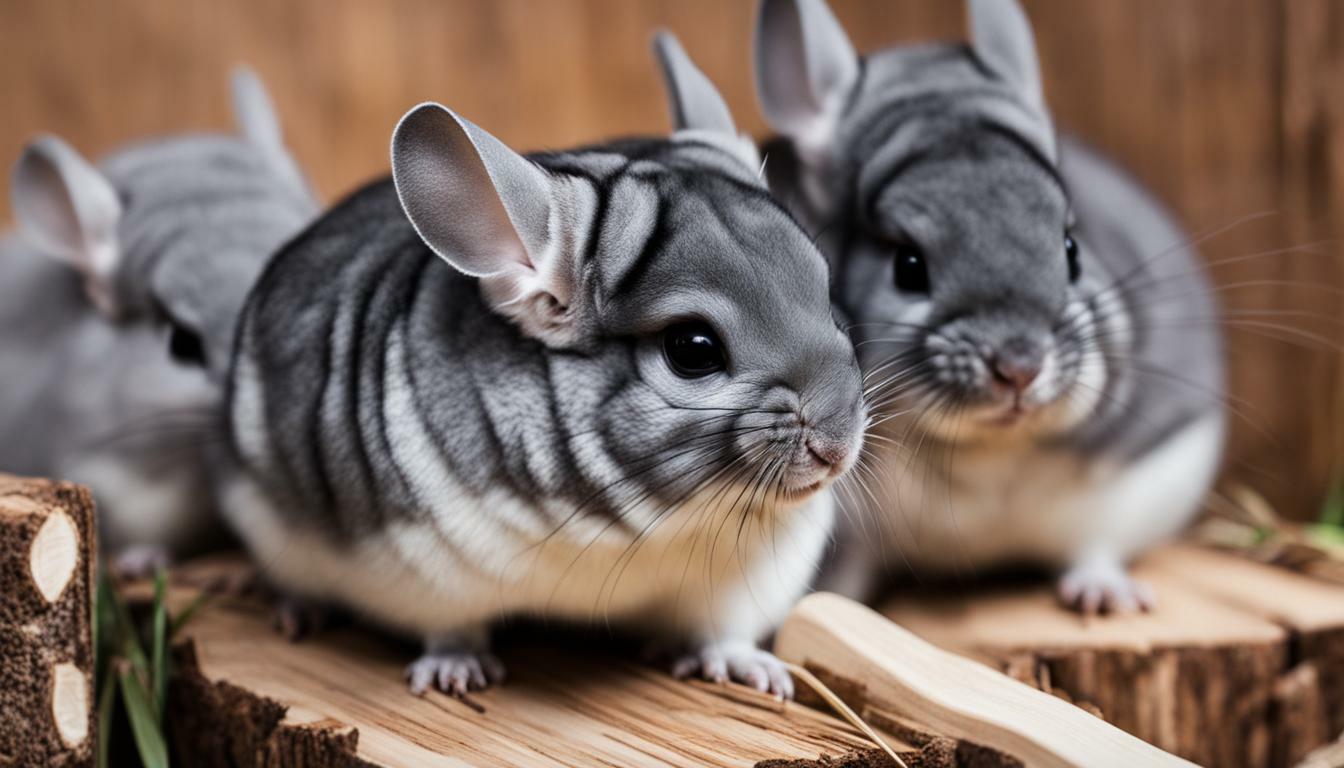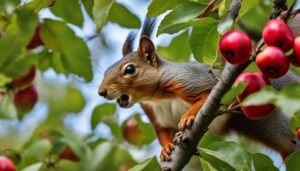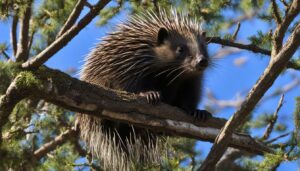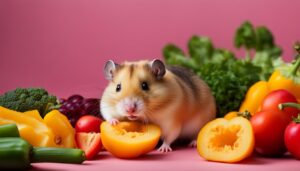When it comes to providing wood for your chinchillas, ensuring their safety is paramount. Choosing the right type of wood for chinchillas is crucial, as they love to chew on various materials to maintain their dental health and satisfy their natural gnawing instincts. However, not all types of wood are safe for chinchillas. It is essential to select non-toxic and pesticide-free options to avoid any potential harm to your furry friends.
Key Takeaways:
- Choose non-toxic and pesticide-free wood for your chinchillas to chew on.
- Safe wood options for chinchillas include silver and common birch, apple, arbutus, aspen, bamboo, cholla, cottonwood, dogwood, elm, hawthorn, hazelnut, kiwi, magnolia, manzanita, mulberry, pear, pecan, pine (oven-baked or kiln-dried only), poplar, quince, rose, sycamore, white birch, willow, and yucca.
- Prepare the wood before giving it to your chinchillas by cleaning, boiling, and baking it until completely dry.
- Ready-to-use wood chews can be purchased online for convenience.
- Other safe materials for chinchilla toys include banana leaf, cardboard, coconut shells, hay cubes, mineral lava, loofah, palm leaves, pine cones (cleaned and baked), pumice stone, seagrass, shredder tape, sisal, sola plant, and vine.
- Avoid giving chinchillas wood that is toxic to them, such as almond, apricot, birch, cherry, cedar, eucalyptus, fir, grapefruit, maple, oak, orange, walnut, and more.
Safe Wood Types for Chinchillas
There are several safe wood types that are ideal for chinchillas, providing not only a comfortable bedding option but also a chewable material for their dental health. When choosing wood for your chinchilla’s environment, it is important to select non-toxic and pesticide-free options to ensure their safety. Here are some of the best types of wood for chinchillas:
| Wood Type | Benefits |
|---|---|
| Silver Birch | Safe and aromatic |
| Apple | Offers a sweet scent |
| Aspen | Soft and gentle on their paws |
| Willow | Great for bedding and gnawing |
These wood types provide a natural and engaging environment for your chinchilla. They can be used as bedding, allowing your furry friend to burrow and nest in a comfortable and safe material. Additionally, these woods are perfect for gnawing, which helps to keep their teeth healthy and promotes natural chewing behavior.
Remember to always monitor your chinchilla’s wood consumption and regularly rotate the bedding and toys to maintain a stimulating environment.
In addition to wood, there are other safe materials that can be used for chinchilla toys. Banana leaf, coconut shells, and cardboard are all suitable options that provide different textures and shapes for your chinchilla to explore and play with. These materials not only offer entertainment but also help to satisfy their natural instinct to chew.
When providing wood or other materials for your chinchilla, it is crucial to avoid toxic options that could harm their health. Wood types such as almond, cherry, cedar, and oak should be avoided as they can be toxic to chinchillas. It’s always better to be safe than sorry, so familiarize yourself with the list of safe and unsafe woods before introducing them to your chinchilla’s habitat.
| Unsafe Wood Types |
|---|
| Almond |
| Cherry |
| Cedar |
| Oak |
By providing your chinchilla with safe wood types and other suitable materials, you can create a stimulating and enriching environment that promotes their well-being.
Preparing Wood for Chinchillas
Before introducing wood to your chinchillas, it is crucial to properly prepare it to ensure their safety and enjoyment. Cleaning and sterilizing the wood will eliminate any potential contaminants or harmful bacteria that could be harmful to your chinchilla’s health. Start by scrubbing the wood with warm water and a mild soap, making sure to remove any dirt, debris, or sap. Rinse thoroughly to ensure all traces of soap are gone.
Once the wood is clean, the next step is to boil it. This process helps to further sanitize the wood and remove any remaining bacteria. Place the wood in a large pot of water and bring it to a boil. Let it simmer for at least 20 minutes to ensure thorough sterilization. Allow the wood to cool completely before moving on to the next step.
After boiling, it is important to dry the wood thoroughly to prevent mold or rot. Start by patting it dry with a clean towel or cloth. Then, place the wood in a well-ventilated area and allow it to air dry completely. Alternatively, you can place it in an oven set to a low temperature (around 200°F) for a few hours until fully dry. Keep a close eye on the wood during this process to avoid any potential fire hazards.
By following these preparation steps, you can ensure that the wood is safe and ready for your chinchillas to enjoy. Additionally, if you prefer convenience, there are ready-to-use wood chews available for purchase online. These chews have already been prepared and sterilized, making them a hassle-free option for your chinchilla’s playtime.
Table: Safe Wood Types for Chinchillas
| Safe Wood Types | Benefits | Suitable for |
|---|---|---|
| Silver and common birch | Gnawing and environmental enrichment | Bedding and playtime |
| Apple, arbutus, and aspen | Natural and non-toxic | Chewing and nesting |
| Bamboo, cottonwood, and dogwood | Durable and safe for play | Gnawing and environmental enrichment |
| Elm, hawthorn, and hazelnut | Varied textures for dental health | Chewing and dental care |
Remember, providing safe wood for your chinchillas is essential for their overall well-being. By taking the time to properly prepare and choose suitable wood options, you can create a stimulating and safe environment for your furry friends to enjoy.
Recommended Wood for Chinchilla Environmental Enrichment
Environmental enrichment plays a vital role in keeping chinchillas healthy and entertained, and certain types of wood can greatly enhance their living space. When selecting wood for chinchilla environmental enrichment, it is important to choose safe options that provide both mental and physical stimulation. Here are some recommended types of wood that are suitable for chinchilla environmental enrichment:
| Wood Type | Benefits |
|---|---|
| Silver and Common Birch | Safe for gnawing and provide entertainment. |
| Apple | Offers a pleasant aroma and encourages natural chewing behavior. |
| Pear | Provides a variety of textures for chinchilla’s teeth and helps keep them healthy. |
| Pine (oven-baked or kiln-dried only) | Can be used for climbing, gnawing, and providing a stimulating environment. |
| Willow | Lightweight and great for gnawing, promoting dental health. |
It is important to note that regardless of the wood type, it is essential to properly prepare it before giving it to chinchillas. This includes cleaning the wood thoroughly, boiling it to remove any potential bacteria or parasites, and baking it until completely dry. Ready-to-use wood chews can also be purchased online, providing convenience and ensuring the wood is safe for chinchillas to use.
Aside from wood, there are other safe materials that can be used for chinchilla toys and environmental enrichment. These include banana leaf, cardboard, coconut shells, hay cubes, mineral lava, loofah, palm leaves, pine cones (cleaned and baked), pumice stone, seagrass, shredder tape, sisal, sola plant, and vine. These materials offer a variety of textures and shapes that can further stimulate and engage chinchillas.
It is crucial to avoid giving chinchillas wood that is toxic to them. Some woods that should be avoided include almond, apricot, birch, cherry, cedar, eucalyptus, fir, grapefruit, maple, oak, orange, walnut, and more. Being aware of these potential dangers can help ensure the well-being and safety of chinchillas in their environment.
| Toxic Woods to Avoid |
|---|
| Almond |
| Apricot |
| Birch |
| Cherry |
| Cedar |
| Eucalyptus |
| Fir |
| Grapefruit |
| Maple |
| Oak |
| Orange |
| Walnut |
Other Safe Materials for Chinchilla Toys
In addition to wood, there are many other safe materials that can be used to create engaging and stimulating toys for your chinchillas. These materials offer a variety of textures, shapes, and colors to keep your furry friends entertained and mentally stimulated.
One popular option is banana leaf. Chinchillas love the natural texture and enjoy shredding and nibbling on the leaves. It provides a great way for them to exercise their teeth and satisfy their chewing instincts. Cardboard is another safe material that can be used to create interactive toys, such as tunnels or mazes. Chinchillas enjoy exploring these structures and chewing on them, providing both mental and physical stimulation.
Coconut shells are also a great option. They can be filled with treats or hay, creating a fun foraging activity for your chinchillas. Chinchillas love the challenge of trying to extract the treats, keeping them entertained for hours. Hay cubes are another safe material that can be used for both chewing and foraging. You can hide small treats inside the cubes, encouraging your chinchillas to nibble and search for their rewards.
| Safe Materials | Usage |
|---|---|
| Banana leaf | Shredding, nibbling |
| Cardboard | Tunnels, mazes |
| Coconut shells | Foraging |
| Hay cubes | Chewing, foraging |
Chinchillas enjoy the challenge of trying to extract the treats, keeping them entertained for hours.
Additional Safe Materials
Other safe materials for chinchilla toys include mineral lava, which can be used as a chewing block to help wear down their teeth. Loofah is a popular material that chinchillas enjoy chewing on due to its fibrous texture. Palm leaves can be woven into a variety of shapes, such as balls or tunnels, providing your chinchillas with a fun and interactive toy.
Pine cones, when properly cleaned and baked, offer a natural and safe chewing option. Chinchillas love to nibble on the scales and extract the seeds, providing both mental and physical stimulation. Sisal rope and shredder tape are safe options for chinchillas to play with. They can be hung inside the cage, encouraging your chinchillas to climb and explore.
Remember to always supervise your chinchillas when introducing new toys or materials to ensure their safety. Rotate the toys regularly to keep the environment fresh and exciting for your chinchillas. By providing a variety of safe materials, you can create a stimulating and enriching environment for your furry friends.
Wood Types to Avoid for Chinchillas
While there are many safe wood options for chinchillas, it is equally important to be aware of the wood types that could be harmful to their health. Chinchillas have sensitive respiratory systems and can be negatively affected by certain types of wood, either due to the natural toxins they contain or the chemicals used in their treatment.
Some wood types that should be avoided for chinchillas include almond, apricot, birch, cherry, cedar, eucalyptus, fir, grapefruit, maple, oak, and orange. These woods can produce toxic oils, resins, or sap that may cause respiratory issues or liver damage when ingested or chewed on by chinchillas. Walnut wood should also be avoided as it contains juglone, a substance that can be toxic to chinchillas, causing digestive problems and skin irritations.
To ensure the well-being of your chinchilla, it is essential to carefully select the wood materials you provide. Always opt for non-toxic and pesticide-free options, and thoroughly research the wood types before introducing them into your chinchilla’s habitat. Consulting with a veterinarian experienced in exotic pet care can also provide valuable guidance in choosing safe wood for your chinchilla’s cages and toys.
| Wood Types to Avoid |
|---|
| Almond |
| Apricot |
| Birch |
| Cherry |
| Cedar |
| Eucalyptus |
| Fir |
| Grapefruit |
| Maple |
| Oak |
| Orange |
| Walnut |
Best Practices for Chinchilla Wood Usage
To ensure the best experience for your chinchillas, it’s important to follow some key practices when it comes to using wood in their habitat. By incorporating these best practices, you can provide a safe and enriching environment for your furry friends.
1. Choose chinchilla-friendly wood options: When selecting wood for your chinchillas, opt for non-toxic varieties that are safe for them to chew on. Some suitable options include silver and common birch, apple, arbutus, aspen, bamboo, cholla, cottonwood, dogwood, elm, hawthorn, hazelnut, kiwi, magnolia, manzanita, mulberry, pear, pecan, pine (oven-baked or kiln-dried only), poplar, quince, rose, sycamore, white birch, willow, and yucca. These woods provide both mental stimulation and a natural outlet for their chewing instincts.
2. Properly prepare the wood: Before giving wood to your chinchillas, it’s crucial to prepare it to ensure their safety. Clean the wood thoroughly to remove any dirt or debris, then boil it to eliminate bacteria and parasites. After boiling, bake the wood in an oven until it is completely dry. This process removes any moisture that may cause mold or rot, making the wood safe for your chinchillas to chew on. Alternatively, you can purchase ready-to-use wood chews from reputable online sources.
3. Explore other safe materials: Wood is not the only material that can provide enrichment for your chinchillas. Consider incorporating other safe materials into their habitat, such as banana leaf, cardboard, coconut shells, hay cubes, mineral lava, loofah, palm leaves, pine cones (cleaned and baked), pumice stone, seagrass, shredder tape, sisal, sola plant, and vine. These materials offer a variety of textures and play opportunities, keeping your chinchillas engaged and entertained.
4. Avoid toxic wood options: It’s essential to be aware of wood types that are toxic to chinchillas. Avoid giving them wood from trees such as almond, apricot, birch, cherry, cedar, eucalyptus, fir, grapefruit, maple, oak, orange, walnut, and others. These woods can be harmful and may cause adverse health effects in your chinchillas. Always double-check the safety of any wood before introducing it into their habitat.
| Safe Wood Options | Toxic Wood Options |
|---|---|
| Silver Birch | Almond |
| Apple | Apricot |
| Aspen | Birch |
| Bamboo | Cherry |
| Cholla | Cedar |
| Cottonwood | Eucalyptus |
| Dogwood | Fir |
| Elm | Grapefruit |
| Hawthorn | Maple |
| Hazelnut | Oak |
| Kiwi | Orange |
| Magnolia | Walnut |
| Manzanita |
Where to Find Safe Wood for Chinchillas
Finding safe wood for your chinchillas is made easier by the availability of dedicated online stores offering a range of chinchilla-friendly products. These stores specialize in providing non-toxic and pesticide-free wood options that are suitable for chinchillas to chew on.
When searching for safe wood for your chinchillas, look for reputable online retailers that offer a variety of chinchilla chew toys made of safe wood. These toys are designed to satisfy your chinchilla’s natural chewing instincts while also providing mental stimulation and environmental enrichment.
In addition to chew toys, these online stores often offer a selection of non-toxic wood accessories for chinchilla cages. These may include platforms, ramps, and hideouts made from safe wood materials. These accessories not only enhance your chinchilla’s habitat but also provide them with additional opportunities for exercise and play.
Before making a purchase, be sure to read product descriptions and customer reviews to ensure that the wood is indeed safe for chinchillas. You can also consult with a veterinarian or experienced chinchilla owners for recommendations on trusted brands and products.
| Safe Wood Types for Chinchillas | |||
|---|---|---|---|
| Silver birch | Apple | Arbutus | Aspen |
| Bamboo | Cholla | Cottonwood | Dogwood |
| Elm | Hawthorn | Hazelnut | Kiwi |
| Magnolia | Manzanita | Mulberry | Pear |
| Pecan | Pine (oven-baked or kiln-dried only) | Poplar | Quince |
| Rose | Sycamore | White birch | Willow |
| Yucca |
Note that this table is not exhaustive, and there may be other safe wood types available for chinchillas in the market. Always prioritize the safety and well-being of your chinchillas by choosing non-toxic and suitable wood options for their environment.
Conclusion
By choosing the right wood types and following proper usage guidelines, you can provide a safe and enriching environment for your chinchillas. When providing wood for chinchillas to chew on, it is crucial to select non-toxic and pesticide-free options. Some safe woods for chinchillas include silver and common birch, apple, arbutus, aspen, bamboo, and many more.
However, it is essential to prepare the wood before giving it to your chinchillas. Cleaning, boiling, and baking the wood until completely dry is necessary to remove any potential contaminants. If you prefer a more convenient option, you can also purchase ready-to-use wood chews from reputable online stores.
In addition to wood, there are various other safe materials that can be used for chinchilla toys. Banana leaf, cardboard, coconut shells, hay cubes, and mineral lava are just a few examples. These materials provide a diverse range of textures and stimuli, promoting both physical and mental enrichment for your chinchillas.
It is important to note that certain wood types should be avoided, as they can be toxic to chinchillas. Examples include almond, apricot, birch, cherry, cedar, eucalyptus, fir, grapefruit, maple, oak, orange, and walnut. Being aware of these harmful woods and avoiding their use is crucial to maintaining the health and well-being of your chinchillas.
By investing in appropriate wood types, preparing it properly, and incorporating other safe materials into your chinchillas’ environment, you can create an engaging and stimulating space for them to thrive. Providing them with the right toys and chews not only helps keep their teeth healthy but also supports their overall physical and mental development. Remember, the well-being of your chinchillas should always be a top priority.
FAQ
What wood is safe for chinchillas?
Safe woods for chinchillas include silver and common birch, apple, arbutus, aspen, bamboo, cholla, cottonwood, dogwood, elm, hawthorn, hazelnut, kiwi, magnolia, manzanita, mulberry, pear, pecan, pine (oven-baked or kiln-dried only), poplar, quince, rose, sycamore, white birch, willow, and yucca.
How should wood be prepared for chinchillas?
Wood should be cleaned, boiled, and then baked until completely dry before giving it to chinchillas.
Are there ready-to-use wood chews available for chinchillas?
Yes, there are ready-to-use wood chews that can be purchased online for convenience.
What other safe materials can be used for chinchilla toys?
Other safe materials for chinchilla toys include banana leaf, cardboard, coconut shells, hay cubes, mineral lava, loofah, palm leaves, pine cones (cleaned and baked), pumice stone, seagrass, shredder tape, sisal, sola plant, and vine.
What wood types should be avoided for chinchillas?
Chinchillas should avoid wood that is toxic to them, such as almond, apricot, birch, cherry, cedar, eucalyptus, fir, grapefruit, maple, oak, and walnut.
What are some best practices for using wood with chinchillas?
Best practices include proper cleaning of the wood, monitoring wood consumption, and regularly rotating toys and bedding materials made of wood.
Where can I find safe wood for chinchillas?
Safe wood options for chinchillas can be found in online stores that offer specially designed chew toys and cage accessories made from non-toxic wood.




